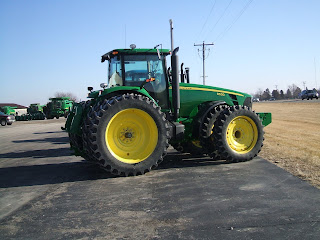This is a copy of a column written by a guy I read regularly. He tends to see things from a liberal point of view and I do not agree with him alot of the time, but I believe that this one column does a great job of explaining some of the current problems in production agriculture. After you have read this, in a couple of days I will post another column from another writer who will show some of the effects of this problem.
Sir Isaac Newton meets Congress
Newton's Third Law of Motion,
"For every action there is an equal and opposite reaction," has direct application to the physics of Farm Bills.
For example, the 1995 Farm Bill, Freedom to Farm or F2F for short, was to run seven years and cost taxpayers $50 billion. Congress, however, wrote such an unbalanced law that it ended the "market-oriented" experiment a year early after the U.S. Treasury blew through more than $100 billion of your money.
Congress's arrogance of accounting -- "$50 billion? $100 billion? Whatever." -- was matched only by its ignorance of physics. F2F's action of unbridling production and subsidy spending delivered a predictable reaction: a nine-year run of over-production, low prices and enormous subsidies.
The opposite and equal reactions to this cheap grain policy then rippled through the rest of agriculture, according to Timothy Wise of Tufts University's Global and Sustainable Development Program.
In a Feb. 26 paper released by Tufts, Wise calculates F2F dropped U.S. corn prices 23 percent and U.S. soybean prices 15 percent below their respective costs of production from 1997 through 2005.
In turn -- and here comes Newton -- livestock "feed prices were an estimated 21 percent below production costs for poultry and 26 percent below costs for the hog industry."
The cheap feed became a windfall for the big pig and poultry gang. Based upon "available market share information," Wise and Tufts policy analysts estimate the "economic savings for the top broiler and hog producers from (the) below-cost feed from 1997-2005" was a collective $19.75 billion.
The flood of institutionalized, cheap feed lifted the biggest boats the highest. Tyson Foods, calculates Tufts, saved an estimated $2.6 billion in feed costs in poultry operations over the nine years; GoldKist saved $1.13 billion; Pilgrim's Pride $1 billion and ConAgra Poultry $900 million.
The pig boys fattened themselves at F2F's trough, too. Smithfield, estimates Tufts, saved $2.54 billion on feed from 1997 through 2005; Premium Standard saved $680 million. Two other pork giants, Seaboard and Prestage benefited to the tune of $678 million and $426 million, respectively.
The cheap feed caused a chain reaction: huge profits funded the continued integration of the meat industry.
In late 2003, Pilgrim's Pride bought competitor ConAgra Poultry for $590 million and leapfrogged GoldKist to become America's biggest cluck. Then, this past January, Pilgrim's Pride completed its purchase of GoldKist (for $1.1 billion) to become the cock of the walk.
The others giants used their F2F savings to integration ends, also. In 2003, Tyson's bought beef giant IBP for $3.2 billion and, on May 4, Smithfield bought Premium Standard for $1 billion.
The F2F-funded concentration and integration of market power had other, on-farm consequences. For example, the number of independent U.S. pork producers fell from 138,690 in 1997 to 65,540 in 2005
In fact, in 2005, only 115 pork operations, or 0.2 percent of all operations, produced 55 percent of all hogs in America. In 1997, that same ratio was 20 times larger: 4 percent produced 55 percent.
All of the above should serve as inarguable background now that Congress is eyeball-deep into writing the 2007 Farm Bill. Its legislative actions, as in 1995 and 2002, will fuel market reactions. Yet, few Farm Bill writers seem to know Newton's Third Law.
As proof, House aggies already are robbing conservation programs to underwrite a massive, near-doubling of the Environmental Quality Incentives Program, a program whose largest beneficiary is big livestock producers.
That action carries this predicable reaction: more and larger animal confinement units, more environmental problems and fewer independent livestock producers.
Farm Bills can do many things, but they shouldn't finance big agbiz getting bigger.
Columnist Alan Guebert has covered food production and ag policy for more than 20 years. He can contacted at agcomm@sbcglobal.net or by writing to 21673 Lago Drive, Delavan, IL 61734
Saturday, June 2, 2007
Understanding the Problems in American Agriculture
Posted by
farmer Tom
at
12:03 PM
![]()
Subscribe to:
Comment Feed (RSS)


|